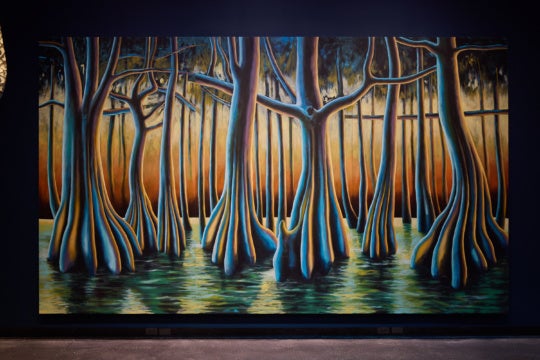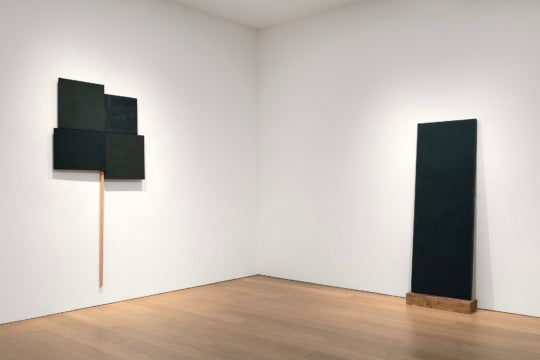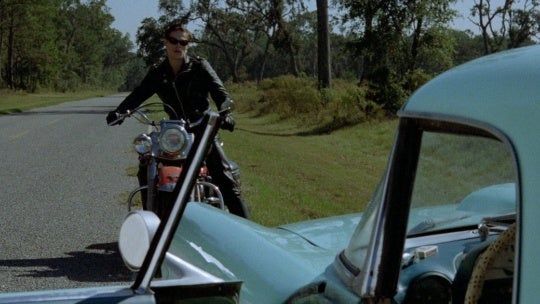It’s hard to imagine what Peggy Guggenheim might have wished for when she blew out the candles on a birthday cake. She had all the money in the world, collected the era’s most significant art, was surrounded by fascinating people, and lived, literally, in a palace.
Still, there was something about her that seemed incomplete, uncertain, dissatisfied. She was always on the lookout for the object or artist that would help complete her sense of self. At least, that’s the impression one comes away with after watching Peggy Guggenheim: Art Addict, a new feature-length documentary film about the 20th century’s arguably most famous art collector. The film, opening on November 27 at the Midtown Art Cinema, was made by Lisa Immordino Vreeland, granddaughter-in-law to the famed Harper’s Bazaar editor Diana Vreeland, who was the subject of Immordino Vreeland’s first documentary, The Eye Has to Travel.
The impression of Guggenheim that emerges from Art Addict is a surprising one because it’s so at odds with our preconceived notions about Peggy Guggenheim. One might imagine her as an outrageously idiosyncratic, garrulous, lusty, sociable heiress, surrounded by yippy dogs and sporting a pair of ludicrously flashy cat-eye sunglasses, radiant with belief in herself. This is perhaps who she wanted to be, or rather, she seemed fine if people got that impression, but the real person, as revealed in the documentary, is different.
Guggenheim was born at the end of the 19th century to one of New York’s wealthiest Jewish families. When she was just 13, her father was among those who went down with the Titanic, after nobly giving his life vest away. Surprisingly, she did not start off fairy-tale rich by Guggenheim standards: speakers in the film even refer to her as “the poor Guggenheim.” She never quite fit into the haute bourgeoisie world of New York; she wasn’t typically pretty or effortlessly charming in the particular way that was considered desirable then. Instead, she began to practice the eccentricity that the women on her mother’s side of the family were famous for, only she did so more deliberately and, since her eccentricity eventually involved art collecting, to greater profit. She became a new type of collector for the new century’s new type of art.
In the 1920s, Guggenheim moved to Paris, where she got to know many of the significant artists and writers of the era, often becoming their patron at crucial points in their careers. In addition, she often became a friend, confidante, and even, with somewhat scandalous frequency, a lover. Her gallery in London, Guggenheim Jeune, gave first exhibitions to Hans Hoffman, Clyfford Still, Robert Motherwell, Mark Rothko, Jackson Pollock, Wassily Kandinsky and many more (An exhibition of children’s paintings included work by the young Lucian Freud, so she technically gave him his first exhibition, as well).
Many people—including much of her family, like her uncle Solomon Guggenheim, who were collectors of more conventional art—thought of her collection as junk. One gets the sense that Peggy wouldn’t have cared if it had all turned out to be worthless; her enthusiasm for her objects was genuine and not contingent upon the estimation of others. But her collection decidedly did not turn out to be worthless junk; much of the artwork that she sold out of her gallery went into the hands of buyers who subsequently donated or bequeathed the works to prominent museums, where they are displayed as exemplars of 20th century art. The pieces that remained in her own collection are considered invaluable; her palazzo on the Grand Canal in Venice is now one of the most significant and popularly visited collections of modern art in the world.
Vreeland’s film utilizes taped biographical audio interviews with Guggenheim from the 1970s, once believed lost, as narration for the film. Guggenheim speaks in a strangely affected voice and accent, which, we learn, is indeed fake; as a girl, she went to a small private school in New York with a group of other extremely wealthy young Jewish girls, and they all learned to talk in that peculiar way. We may expect Guggenheim’s reminiscences to be outrageous, recounted in vivid detail, but she’s a surprisingly colorless speaker. In an early exchange, her biographer and interviewer eagerly prompts her to tell a story about James Joyce, whom Guggenheim knew in Paris, asking if he was truly as wild as people say and if he would really dance a jig at the end of a debauched evening. “Yes,” Peggy replies quietly. “He was like that.” This is the most central and surprising discovery about Guggenheim: she was kind of dull.
Unable to forge her own identity, Guggenheim created a personality through art, other people’s art. By anyone’s guess, this would be a doomed enterprise, but the story of Peggy Guggenheim, indeed the story of 20th-century art, is the story of her incredible success.
Peggy Guggenheim: Art Addict begins its weeklong at the Midtown Art Cinema in Atlanta on Friday, November 27.
Andrew Alexander is an Atlanta-based critic who covers visual art, dance, and theater.






